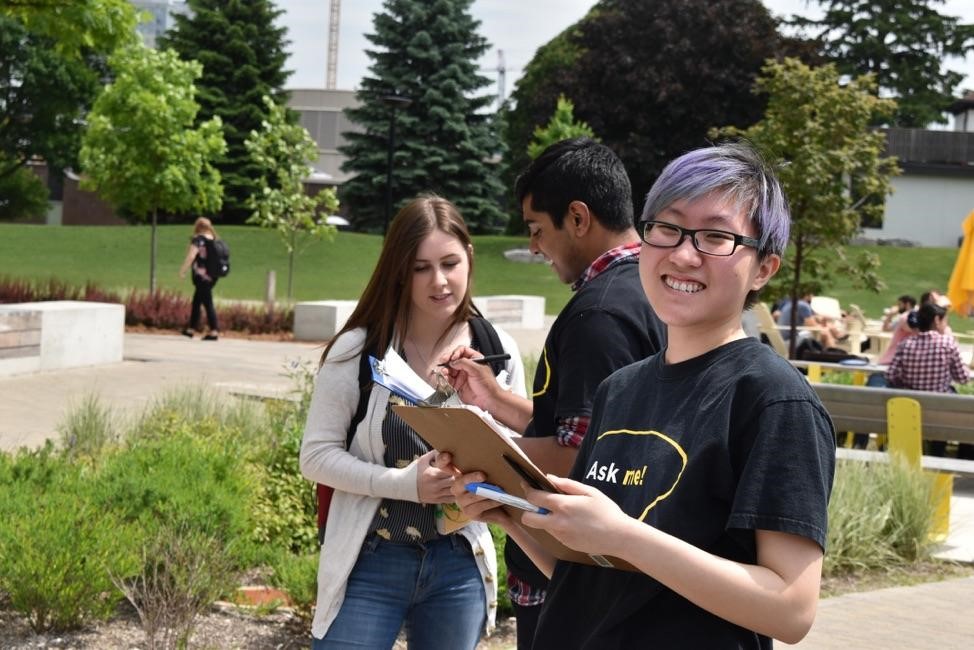Libraries serve so many different groups, and academic libraries have the unique task of appealing to vastly different, yet highly specific users – from kids right out of high school to established academics. A key function of academic libraries is to support the success of undergraduate students, but this comes with a number of hurdles; academic libraries are often perceived as stuffy and intimidating institutions, and the range of services and resources available are unknown to students who have only accessed public and school libraries in the past.
With a strong background in working frontline service desks and with student staff, University of Waterloo’s new Library Communications Team set out to define a brand strategy specifically for student-focused communications and outreach. Dubbed Serious Fun, this style of storytelling promotes the library’s expertise, services and curated resources in a continuously evolving way that finds students in the physical and digital spaces they inhabit, in the voice of their peers.
Serious Fun encompasses web and social media content, events, wellness promotion, passive and active programming, and a unique staffing model – all designed to appeal to the undergraduate student demographic, with the hope of getting them hooked for life.
Friends don’t let friends miss out on library services
 A key component of Serious Fun is speaking to students through students. The Library Ambassadors program hires students with little to no work experience, but a lot of passion for the Library and University. These students take that passion – and intensive Library outreach training – across campus, into their classes and online, creating a peer-to-peer platform for introducing students to all the Library has to offer.
A key component of Serious Fun is speaking to students through students. The Library Ambassadors program hires students with little to no work experience, but a lot of passion for the Library and University. These students take that passion – and intensive Library outreach training – across campus, into their classes and online, creating a peer-to-peer platform for introducing students to all the Library has to offer.
Orientation week and September service fairs are most students’ first impression of campus life. Meeting fellow students – wearing ‘Ask me’ shirts and armed with candy, collectible buttons, and a selfie-ready mascot – means new students are far more likely to walk away with that package of important library information. Packages listing the services that will support their academic success also include library social media handles and upcoming outreach events to encourage continued engagement, even if they’re not ready to access library services. Making this first contact with the library a fun peer-to-peer experience has seen the number of information packages distributed during orientation week grow from a few hundred to almost 4,000.
Using student ambassadors to gather user feedback encourages students to speak freely about their needs and concerns, and peer-to-peer interactions on important academic topics are more openly received and come across as less preachy. A university administrator commented on the benefits of having the Library Ambassadors partner with the Office of Academic Integrity on their own outreach: “I think having a student coach another student on what academic integrity is, and how to avoid plagiarism, is powerful as students are more likely to take advice from peers.”
 Speaking their language
Speaking their language
Students are always on their phones these days…so why shouldn’t the library be on their phones too? Taking advantage of student project work, the library’s social media presence was analyzed by a team of consultants in a speech and communications course. This allowed the Library to get a better understanding of the target audiences on each platform, and what content resonated well and had the best reach and most interaction.
Knowing that Instagram was the library’s fastest-growing social media platform enabled the Student Engagement Coordinator to focus energy on producing fun and graphic content that is accessible and relatable to undergrads—employing memes, pop culture references and vocabulary that might make an English professor cringe.
The writing style of feature news stories, published on the website and other campus media outlets, has a humorous and conversational feel to it. Abandoning the formal report-style writing of previous news features, you will now often find slang, alliteration and puns popping up in promotional pieces.
Speaking the language of students doesn’t always mean finding the right words. Using emojis has become a fun and interactive way to engage students with what the library has to offer. Creating emoji riddles that give clues to the different services available in the library has resulted in high engagement with students on social media – making a game out of educating users about library services.
Tag, you’re it
Ensuring users see themselves reflected in library content goes beyond tailoring the work of communications staff. User-generated content has proved to be an effective and efficient way of building followers.
Create-your-own meme contests are a quick, fun and rewarding way for users to share their library knowledge, while providing the library with an opportunity to promote copyright through the use of Creative Commons images. Library Ambassadors – full-time students themselves – create content for the Library through blog posts and Instagram takeovers. Students are given the opportunity to express themselves (and provide useful feedback) with ‘thought tree’ and book spine poetry activities during events. Reposting user images on social media also showcases different perspectives of the library, allows students to feel seen and heard, and is an almost effortless source of content.
The Student Engagement Coordinator has increasingly leveraged social media connections through green screens and photo booths at events – green screen activities during Goose Week and the Accio Potterheads event have an “it” factor with students. At Library Day, the Student Engagement Committee had permission to create a life-sized cut-out of University of Waterloo’s President, and students had the opportunity to have their picture taken by library staff with this local celebrity. The photos from these events are then shared on to Facebook and students are compelled to tag, share, or comment on photos of themselves. This method of user-generated content allows staff to retain control of the library’s image, while still tapping into the students’ desire for ‘cool pics’ that are shareworthy.
 Having fun isn’t hard when you have a library card
Having fun isn’t hard when you have a library card
“I didn’t know the Library had/did that” is a common phrase heard around campus when students connect the dots about what their library card can do for them. While the use of pop culture references, memes, and lingo is important to be able to relate to student users, it is equally important that the library provides information about the resources available to them. Mixing active and passive programing has had success in engaging a wide variety of users. Active programing includes activities that engage directly with people and are offered at a specific time, while passive programing referrers to activities that students can do independently and at their leisure. The past year has seen events successfully combine active and passive programming allowing students to interact in a capacity they are comfortable with. These dynamic experiences support the library’s welcoming image and a vibe that lets students know the library is for everyone, and not just a specific ‘type’ of student.
The library employed a mix of active and passive programing into all of the past year’s keystone events. Library Day is an annual event celebrating library users during Canadian Library Month, with a Fall Fair theme, including carnival games, food, and a photo booth. Students are able to celebrate alongside staff to whatever degree they are comfortable with. Surprisingly, library-themed games (Library services emoji game, spine poetry) were more popular than the traditional carnival games.
Leaning in to embrace the university’s unofficial mascot (the Canada Goose) and spoofing on Shark Week, the Student Engagement Committee launched a full week of activities branded Goose Week. Activities ranged from goose social art and goose stretches, to a goose book display and geese myths or facts game using golden eggs.
Most recently, the Student Engagement Committee hosted its first Trick or treat yo-self to library resources and candy event. On Halloween, students were handed a trick-or-treat bag and encouraged to visit tables staffed by a variety library departments. Students interacted with staff, asked questions, or collected informational handouts and in return received a piece of candy. Department Heads, liaison librarians, and staff from across the library participated in this event, educating students on their unique services. One staff member commented, “students seemed really engaged, not just out for candy, lol!”
Making dreams come true
Hosting wellness activities in each term has not always been an easy sell for staff–many feel this approach is beyond the scope of an academic library. While most of the library’s events and outreach activities contain educational elements, some are purely to support mental and physical well-being. Activities such as therapy dogs, healthy snacks, stretch breaks and Harry Potter parties might get students into the Library for the first time ever. Handing a student their entrance letter to Hogwarts as they walk into the room and hearing them say “This has been my dream since I was a child,” fosters connections between students and staff and make students feel cared for.
Wellness events engage students with different spaces in the library, increase the approachability of the institution, and create a comfort level with staff. Reinforcing the importance of taking study breaks and maintaining health during the most stressful times of the year also promotes sustainable study habits.
The library’s next venture is a holiday themed event called Holi-yay! from the Library. Each semester the library provides supplies for students to create their own exam stress packs. This holiday season, the Student Engagement Committee is making these care packages for students, including library resources, hot chocolate, candy, and resources from campus partners, combining fun, education and wellness in one activity.
The impact wellness events have on supporting student success is evident in student feedback overhead following a recent therapy dog session: “This is the best I have felt in 10 months, now I can go write my midterm.”
Work hard, play hard
When writing in a more casual and student-focused style, extra thought is required to ensure the tone and content still reflects the ‘seriousness’ of the story being told: the expertise of an academic library. It also requires ongoing research and staying up-to-date on vocabulary, trends in social media, and what’s trending on social media. The Student Engagement Coordinator devotes time each week to researching trends in social media, academic libraries, and popular memes and cultural references that could be used to tell our story.
Mind the gap
Serious Fun didn’t happen overnight, but was a synergistic effort between the Student Engagement Committee and Communications Team over time. The Serious Fun brand has guided the library’s communications, interactions with students, and events. Students are thirsty for experiences that showcase who they are and align with their sense of self, values, and image, and all of this can be done with Serious Fun. There are countless ways libraries can embody the Serious Fun philosophy for deeper engagement with their users. It is critical that libraries have a solid understanding of the impacts of the messaging that comes out of events and communications. There must also be an awareness of potential gaps (misunderstandings, too serious, bland), but with a strong team effort and focused direction, libraries can mind the gap and create experiences for students that are meaningful, educational, and serious fun!
Mary Lynne Bartlett, Student Engagement Coordinator, and Sara Perkins, Communications Officer, work at the University of Waterloo Library. Both think their jobs are Serious Fun.

